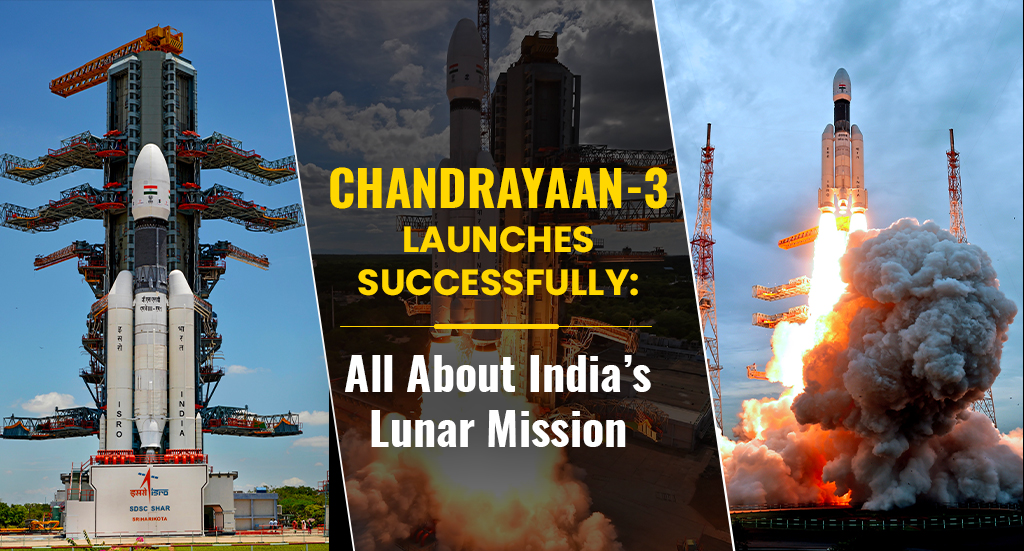India took the first successful step to redeem its mission to explore the moon with the successful launch of its third lunar mission- Chandrayaan-3. The lift-off by ISRO took place at 2:35 pm from the Satish Dhawan Space Centre in Sriharikota. The spacecraft, on board the rocket LVM3— dubbed the Bahubali rocket— has been put on a trajectory that will take it into lunar orbit.
With the launch of Chandrayaan-3, India aims to demonstrate a safe and soft landing on the moon’s surface, to demonstrate Rover roving on the Moon, and to conduct in-situ scientific experiments. India will be the fourth country to land on the moon, after the United States, China, and Russia— and the second after China this century— if the mission is successful.
The spacecraft is estimated to take about a month to reach the moon from the Earth. The landing is expected on August 23. Upon landing, it will operate for one lunar day, which is approximately 14 Earth days. After the moon rendezvous, the Chandrayaan 3 spacecraft will be separated from the rocket.
After Chandrayaan 3’s launch earth-centric orbit by the LVM3, the ISRO will conduct five orbit-raising measures spread out over 21 days, where the spacecraft is brought closer to the moon’s orbit and later transferred into the moon’s orbit.
This is ISRO’s second attempt to touch down a robotic lander on the moon’s surface. It was last attempted in September 2019. The objective of the second lunar mission, Chandrayaan-2, was to make a soft landing on the moon’s surface. The mission failed since the Vikram lander, which was expected to make contact with the moon, crash-landed just minutes before the touchdown and lost contact with ISRO. The lander tilted 410 degrees instead of the planned 55 degrees, leading to its crash-landing. The small landing site was also attributed as a reason for the failure.
ISRO chairman S Somnath had said ahead of the launch that this time, the lander has been loaded with more fuel, provided with several safety measures, and will land at a bigger landing site to ensure a successful landing.
“This time we have loaded the lander with more fuel, provided a slew of safety measures, and kept a bigger landing site to ensure a successful landing. This time we have a very clear image of the landing site as the Chandrayaan-2’s orbiter camera (OHRC) has provided us with high-resolution images of the entire Moon. Unlike last time when we were dependent on lander images to see the landing site, this time we know the landing site well in advance as all boulders and craters have already been mapped.”
Chandrayaan-3 consists of the Vikram lander, the Pragyan rover, and a Propulsion module (PM)- all three will develop and demonstrate technologies needed for inter-planetary missions. The Lander will have the capability to soft land at a pre-determined lunar site and deploy the Rover which will move on the lunar surface and carry out in-situ chemical analysis. The Lander and the Rover have scientific payloads to carry out experiments on the lunar surface. The Propulsion Module will carry the Lander Module (LM) from launch vehicle injection till the final lunar 100 km circular polar orbit, and subsequently separate from it. The PM also has one scientific payload to study the spectral and Polari metric measurements of Earth from the lunar orbit. It is a value addition that will be operated after the separation of the Lander Module.
The lander payloads will measure the thermal conductivity and temperature, and seismicity around the landing site, and estimate the plasma density and its variations. A passive Laser Retroreflector Array from NASA has been incorporated to carry out lunar laser ranging studies.
The Rover payloads include the Alpa Particle X-ray Spectrometer (APXS) and Laser Induced Breakdown Spectroscope (LIBS) for determining the elemental composition around the landing site.








